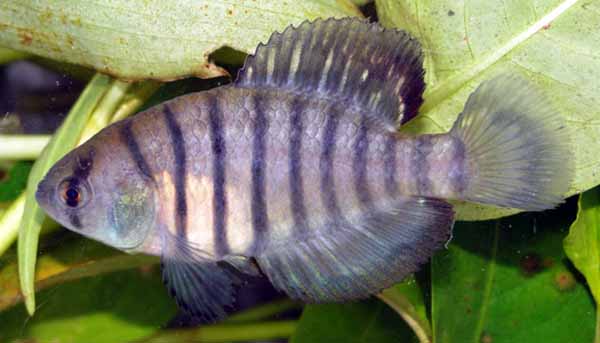Garcialebias nigrofasciatus: Unterschied zwischen den Versionen
Es (Diskussion | Beiträge) |
Thomas (Diskussion | Beiträge) |
||
| Zeile 16: | Zeile 16: | ||
'''Holotypus:''' [[Type#M|MCP]] 21172.<br /> | '''Holotypus:''' [[Type#M|MCP]] 21172.<br /> | ||
'''Paratypen:''' [[Type#M|MCP]] 21173 (6); [[Type#M|MUCP]] 2561 (5); [[Type#U|UFRJ]] 4014 (7c & s), 4015 (26), 4016 (9), 4218 (11), 4219 (19), 4259 (13), 5343 (15).<br /> | '''Paratypen:''' [[Type#M|MCP]] 21173 (6); [[Type#M|MUCP]] 2561 (5); [[Type#U|UFRJ]] 4014 (7c & s), 4015 (26), 4016 (9), 4218 (11), 4219 (19), 4259 (13), 5343 (15).<br /> | ||
| − | '''Typusfundort:''' Temporärer | + | '''Typusfundort:''' Temporärer Tümpel in Pontal da Barra, Praia de Laranjal, Pelotas, Bundesstaat Rio Grande do Sul, Brasilien. |
== Etymologie == | == Etymologie == | ||
| − | . | + | Aus dem Lateinischen ''nigrum'', schwarz, und ''fasciatus'', gestreift, in Bezug auf das Farbmuster der männlichen Tiere der neuen Art. |
== Verbreitung == | == Verbreitung == | ||
| − | . | + | Flusssysteme am linken Rand des Kanals von São Gonçalo, Laguna dos Patos-System, Bundesstaat Rio Grande do Sul, Südbrasilien. |
== IUCN Status == | == IUCN Status == | ||
| Zeile 38: | Zeile 38: | ||
'''NE''' Not Evaluated (nicht beurteilt)]] | '''NE''' Not Evaluated (nicht beurteilt)]] | ||
| − | '''Status:''' Stand | + | '''Status:''' Stand 07.03.2021: '''NE''' Not Evaluated (nicht beurteilt)<br /> |
==Literatur== | ==Literatur== | ||
| − | {{Costa & Cheffe, 2001}}[: 187 | + | {{Barbosa et al., 2019}}[Genetik] |
| − | + | {{Costa et al., 2017}}[Farbfoto] | |
| − | + | {{Costa, 2006a}}[:129, Farbfoto, Beschreibung, Verbreitung, Morphologie] | |
| + | {{Costa & Cheffe, 2001}}[:187, <span style="color: red">'''!!'''</span>] | ||
| + | |||
===Links=== | ===Links=== | ||
Version vom 7. März 2021, 12:23 Uhr
Costa & Cheffe, 2001
|
Familie: Rivulidae |
Typen
Holotypus: MCP 21172.
Paratypen: MCP 21173 (6); MUCP 2561 (5); UFRJ 4014 (7c & s), 4015 (26), 4016 (9), 4218 (11), 4219 (19), 4259 (13), 5343 (15).
Typusfundort: Temporärer Tümpel in Pontal da Barra, Praia de Laranjal, Pelotas, Bundesstaat Rio Grande do Sul, Brasilien.
Etymologie
Aus dem Lateinischen nigrum, schwarz, und fasciatus, gestreift, in Bezug auf das Farbmuster der männlichen Tiere der neuen Art.
Verbreitung
Flusssysteme am linken Rand des Kanals von São Gonçalo, Laguna dos Patos-System, Bundesstaat Rio Grande do Sul, Südbrasilien.
IUCN Status

CR Critically Endangered (vom Aussterben bedroht)
EN Endangered (stark gefährdet)
VU Vulnerable (gefährdet)
NT Near Threatened (potenziell gefährdet)
LC Least Concern (nicht gefährdet)
RE Regionally Extinct (regional oder national ausgestorben)
DD Data Deficient (ungenügende Datengrundlage)
NE Not Evaluated (nicht beurteilt)
Status: Stand 07.03.2021: NE Not Evaluated (nicht beurteilt)
Literatur
- Barbosa, C., Garcez, D.K., Volcan, M.V. & Robe, L.J. 2019. Evidences for genetic differentiation within the highly endemic and endangered annual fish Austrolebias nigrofasciatus (Cyprinodontiformes: Rivulidae). Journal of Fish Biology, 96 (1) [für 2020]: 154-167. Vorab publiziert: 12. November 2019. (doi) Zitatseite [Genetik]
- Costa, W.J.E.M., Cheffe, M.M. & Amorim, P.F. 2017. Two new seasonal killifishes of the Austrolebias adloffi group from the Lagoa dos Patos basin, southern Brazil (Cyprinodontiformes: Aplocheilidae). Vertebrate Zoology, 67 (2): 139-149. (PDF) Zitatseite [Farbfoto]
- Costa, W.J.E.M. 2006. The South American annual killifish genus Austrolebias (Teleostei: Cyprinodontiformes: Rivulidae): phylogenetic relationships, descriptive morphology and taxonomic revision. Zootaxa, 1213: 1-162. Zitatseite [:129, Farbfoto, Beschreibung, Verbreitung, Morphologie]
- Costa, W.J.E.M. & Cheffe, M.M. 2001. Three new annual fishes of the genus Austrolebias from the Laguna dos Patos system, southern Brazil, and a redescription of A. adloffi (Ahl) (Cyprinodontiformes: Rivulidae). Comunicações do Museu de Ciências de PUCRS, 14 (2): 179-200. Zitatseite [:187, !!]
